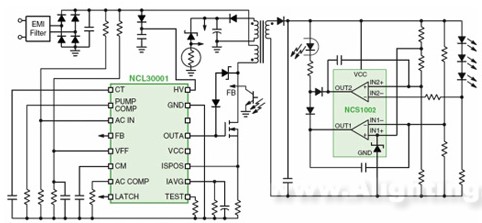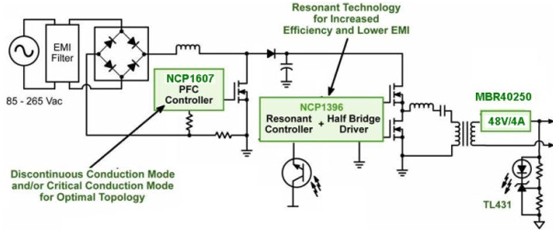High-intensity gas discharge lamps (HIDs) such as high-pressure sodium lamps (HPS) are characterized by high light intensity and long life, and are widely used in regional lighting applications such as street lighting, parking lots, and parks. On the other hand, high-brightness white light-emitting diodes (LEDs) continue to improve in terms of performance and cost, making them ideal for regional lighting applications, and offering some advantages that HID does not have, such as better directionality, better color quality, and environmental protection. And its opening and closing can be more conveniently controlled, it is convenient to automatically detect ambient light to change the brightness; in addition, the reliability of the LED is better, which helps to reduce maintenance costs and total cost of ownership.
Of course, the use of LEDs in street and area lighting applications to replace HIDs and produce equivalent light output requires large arrays of LEDs. To drive these large arrays of LEDs, designers can choose from different options. In addition, the brightness of different LED strings needs to be consistent. If an LED has an open circuit failure, it may cause the whole series of LEDs to be turned off. Therefore, it is necessary to take care of the solution for providing protection for the LED strings. In addition, to build a networked intelligent LED street light control system, it is also necessary to adopt a suitable communication and line drive scheme. These issues and the corresponding ON Semiconductor solutions are discussed below.
LED street light and regional lighting drive power selection
The power of regional lighting applications is typically above 40 W. Different power schemes can be used to drive the LED array depending on the application conditions or requirements. As the premier supplier of high-performance, energy-efficient silicon solutions for green electronics, ON Semiconductor offers different power solutions for LED street lights and regional lighting to meet different customer needs.
1) Current adjustable constant current power factor correction area illumination LED power supply based on NCL30001
Some area lighting applications require an isolated regulated output voltage with input power factor correction. These applications typically employ a two-stage power conversion architecture in which the boost power factor correction (PFC) converts and pre-regulates the AC input line voltage to 400 V DC and then provides the voltage to a conventional topology that can be any suitable topology. DC-DC converters (typically flyback converters in applications where the power does not exceed 150 W).
We can use an easier way to improve this traditional two-stage conversion architecture, making it a single-segment architecture with integrated power factor correction and main converter (ie DC-DC converter). This single-stage architecture offers significant application advantages because of the large size of boost inductors, high voltage MOSFETs, power rectifiers, and large capacitors. Of course, this single-segment architecture brings some performance tradeoffs in some respects, but it is an energy-efficient and cost-effective solution for applications with relatively constant loads, such as LED area lighting.
The NCL30001 is a single-stage controller that integrates power factor correction and isolated step-down DC-DC conversion circuitry to help reduce component count, system cost, and support for higher overall LED power efficiency. The NCL30001 provides constant current and constant current to directly drive the LED, eliminating the linear or DC-DC conversion integrated in the LED strip (Figure 1). An ON Semiconductor design note AND8427 describes an LED power supply based on the NCL30001 single-segment continuous current mode (CCM) PFC controller and the NCS1002 secondary-side constant-voltage constant current (CVCC) controller for area lighting applications such as street lights.

Figure 1: NCL30001-based LED driver solution for 40 to 125 W area lighting applications
Tests have shown that at 90 to 264 Vac input voltage, the NCL30001-based LED power supply provides greater than 85% energy efficiency, power factor is also higher than 0.9, and provides short-circuit and over-voltage protection. By slightly adjusting the resistance in the secondary side control circuit, the designer can adjust the steady current and the regulated voltage to support the specific application requirements of the end product. It is also worth mentioning that although this power supply is designed to provide a fixed current with tight current regulation, it can also operate in a constant voltage mode because its current and voltage are based on the tightly regulated 2.5 V reference voltage integrated in the NCS1002. To stabilize the flow and voltage regulation.
2) Ultra-high energy efficiency high power LED street light power solution based on NCP1607 and NCP1397
In recent years, the industry has become more interested in ultra-high-efficiency LED lighting topologies, expecting to provide more than 90% energy efficiency at relatively low power levels (<50 W). This energy efficiency target is even better than Energy Star 2.0. The external power supply efficiency of the version (higher than 87% when the power is less than 49 W) is higher. To achieve such high energy efficiency, a new topology, such as a flyback topology to a resonant half-bridge topology, is needed to take advantage of zero-voltage switching (ZVS). Advantageously, ON Semiconductor has already begun to develop energy-efficient half-bridge solutions for LED driver power supplies, such as the NCP1396 and its upgraded NCP1397 high-performance resonant mode controller. The NCP1397 has built-in high-end and low-side drivers that support adjustable and precise minimum frequencies, provide extreme energy efficiency, and offer a variety of fault protection features. The LED power scheme based on the NCP1607 PFC controller and the NCP1397 dual inductor plus single capacitor (LLC) half-bridge resonant controller (Figure 2) is ideal for energy efficient LED street lighting applications with power ranges from 50 to 300 W.

Figure 2: Street Lighting Energy Efficient LED Power Solution Based on NCP1607 and NCP1397
In addition to these solutions, designers can also choose other LED power solutions from ON Semiconductor, such as the NCP1607 PFC controller + NCP1377 quasi-resonant controller, or NCP1607+NCP1392/3.